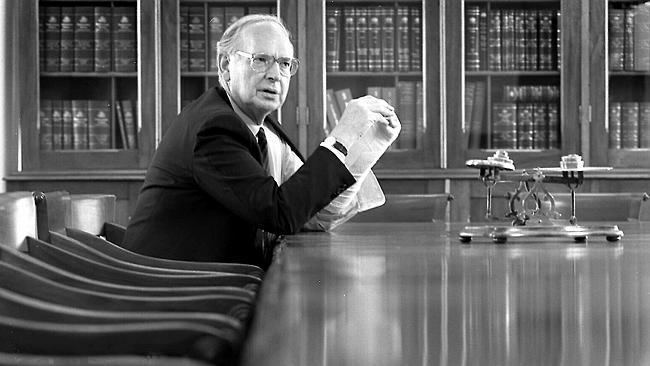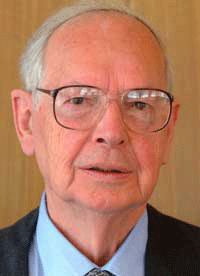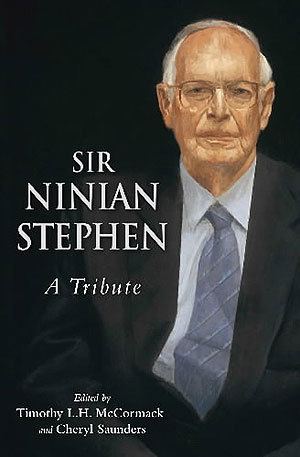Children 5 Name Ninian Stephen | Nominated by William McMahon Role Jurist Preceded by Sir Victor Windeyer | |
 | ||
Prime Minister Malcolm FraserBob Hawke Spouse Valerie Sinclair (m. 1949) Books Australian Citizenship for a New Century, Constitutions | ||
G g ninian stephens arrive at federation pavilion
Sir Ninian Martin Stephen KG, AK, GCMG, GCVO, KBE, QC (born 15 June 1923) is a former Australian judge who served as the 20th Governor-General of Australia, in office from 1982 to 1989. He was previously a Justice of the High Court of Australia from 1972 to 1982.
Contents
- G g ninian stephens arrive at federation pavilion
- Australian judge Sir Ninian Stephen Died at 94
- Legal career
- Judicial career
- Governor General
- Later work
- Titles styles and honours
- Titles
- Honours
- Appointments
- Private life
- References

Stephen was born in England to Scottish parents. As a child he lived for periods in France, Germany, Scotland, and Switzerland, eventually arriving in Australia at the age of 16. Stephen served with the Australian Army during World War II, and after the war entered the legal profession. He became one of Australia's leading constitutional lawyers. Stephen was appointed to the Supreme Court of Victoria in 1970, and then to the High Court in 1972, aged 48. He was considered a member of the court's "moderate centre". In 1982, Stephen was appointed governor-general on the recommendation of Malcolm Fraser. He approved two double dissolutions during his time in office, the only governor-general to do so.
Australian judge Sir Ninian Stephen Died at 94
Legal career
By the 1960s, Stephen was one of Australia's leading constitutional and commercial lawyers. He was made a Queen's Counsel in 1966.
Judicial career

On 30 June 1970, Stephen was appointed as a judge of the Supreme Court of Victoria, which is the highest ranking court in the Australian State of Victoria. He held this position until 29 February 1972, relinquishing it to take up his appointment as a Justice of the High Court of Australia.
Although Stephen was appointed by a Liberal government, he proved not to be a traditional conservative upholder of states' rights. He joined the "moderate centre" of the court, between the arch-conservatism of Sir Garfield Barwick and the radicalism of Lionel Murphy. In 1982 he was part of the majority that decided on a broad interpretation of the "external affairs power" of the Australian Constitution in the Koowarta v Bjelke-Petersen case.
Governor-General
In March 1982, on the advice of the Prime Minister, Malcolm Fraser, Elizabeth II, Queen of Australia appointed Stephen as Governor-General. He was sworn in on 29 July 1982, on the retirement of Sir Zelman Cowen. When Fraser was defeated by the Labor Party under Bob Hawke in 1983, Stephen had no difficulty working with a Labor government. In 1987, on Hawke's advice, the Queen extended Stephen's term by 18 months as a mark of personal respect and also to allow Bill Hayden (to whom Hawke had promised the position) to leave politics at a time of his choosing. Stephen is the only governor-general to have approved two double dissolutions – in 1983 (Malcolm Fraser) and 1987 (Bob Hawke).
Later work
In 1989, Stephen became the first Australian Ambassador for the Environment and, in his three-year term, was particularly energetic in working for a ban of mining in Antarctica. In 1991 he undertook a difficult task when he was appointed chairman of the second strand of the Northern Ireland peace talks. From 1991 to 1995, he was a judge ad hoc of the International Court of Justice in the case East Timor (Portugal v. Australia) 1991–1995. From 1993 to 1997, he was a judge on the international tribunals investigating war crimes in Yugoslavia and Rwanda. He has also been chairman of the Citizenship Council since 1998. In 1994, he acted as a special envoy of the UN Secretary General to resolve political conflicts in Bangladesh.
Stephen has since moved back into the legal field, becoming president of an arbitral tribunal constituted under Chapter 11 of the North American Free Trade Agreement (NAFTA), charged with the adjudication of an investment dispute between Mondev, a Canadian investor, and the United States of America.
Titles, styles and honours
Stephen was made a Knight Commander of the Order of the British Empire (KBE) on 20 April 1972 "for distinguished services to the Law" and sworn of the Privy Council in 1979. As Governor-General he was made a Knight of the Order of Australia (AK), Knight Grand Cross of the Order of St Michael and St George (GCMG) and Knight Grand Cross of the Royal Victorian Order (GCVO). In 1994 Queen Elizabeth II appointed him a Knight of the Garter (KG), being the most recent Australian to be granted a knighthood in the personal gift of the monarch of Australia. He therefore has the unusual distinction of holding five separate knighthoods and joined Lord Casey and Sir Paul Hasluck as one of the few Australian Knights of the Garter. In 1983 he was named a Commandeur of the French Légion d'honneur.
Stephen delivered the first Sir Ninian Stephen Lecture at the University of Newcastle's law school in 1993, giving his name to this lecture series.
A detailed scholarly biography of Stephen, Fortunate Voyager by Philip Ayres, was released in September 2013. Drawing upon it, Ayres has also summarised Stephen's career at the Victorian Bar.
Titles
Honours
Appointments
Private life
Stephen married Valerie Sinclair in 1949 and they have five daughters. One of the daughters, Mary, was married to Peter Hayes QC. He appears to have been unrelated to the Stephen family, a prominent legal dynasty in Australia.
Stephen and his wife are patrons of the Australian Inland Botanic Gardens.
